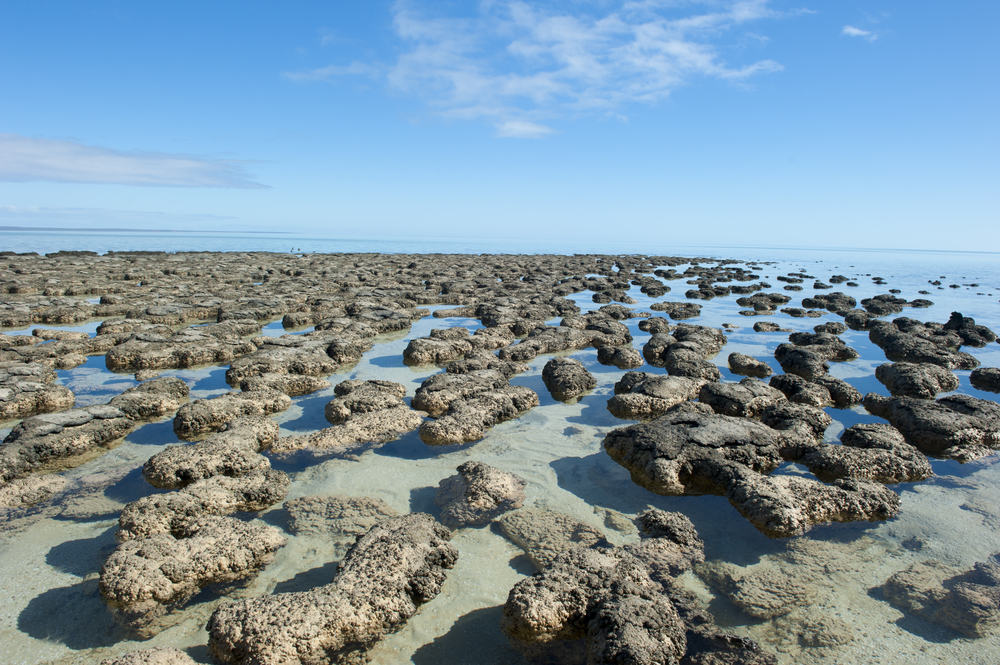I’ll show you life in a handful of dust
Introduction
It’s natural and healthy to maintain an optimistic persona and this must influence our scientific interests too. In this blog I have written far more postings based on beginnings rather than endings, the positive rather than the negative; even recent postings on disease reflect what we can do to understand the nature and scientific basis of the disease with a view to improving man’s lot on the planet.
In this posting things get a little more concerned with endings, not our own in a personal sense, but endings of species, genera and even higher phylogenetic levels. Mass extinction events are what we are concerned with in this and particularly, the next posting. It may seem morbid to concern ourselves with mass extinction events which, if the currently available theories to explain their origin are correct, we may have little ability to affect their potency and outcome, but there is some reason for optimism too. Although mass extinctions have occurred in the past, indeed it is considered that 5 have occurred on the planet, life is still present. Mass extinction events notwithstanding, I think this to be a beautiful place, not the bomb site of the Garden of Eden, and the biological, chemical and physical laws which encode its survival, even against chaotically orchestrated destruction, are a lifetime wonder to me.
Early life
The currently held view is that the earth formed from a planetary accretion disc of rock and gasses swirling around the sun about 4.5 billion years ago. The early conditions of continuous bombardment by meteors, lack of atmosphere and water would have precluded the development of life and it was not until 1 billion years later that we have any evidence of life developing on the planet. Whether this was de novo, that is life developed on earth rather than was seeded in some way by incoming material such as comets, is not known and it is this interesting question that the comet lander Philae may be able to start to unravel.
The earliest forms of life for which we have evidence are Stromatolites. The picture below was taken by Paul Harrison and shows modern day Stromatolites growing in Shark Bay, Australia. These hummocks consist of mineral salts and fine grain sediment from sea water held in place by a mucilaginous biofilm of microorganisms such as cyanobacteria. Cyanobacteria used to be referred to as “Blue-Green Algae”, but since these are examples of prokaryotic cellular life and the term “algae” is applied to eukaryotic life forms such as the Fucus species found commonly on UK sea shores, the more recent name “Cyanobacteria” is more appropriate.
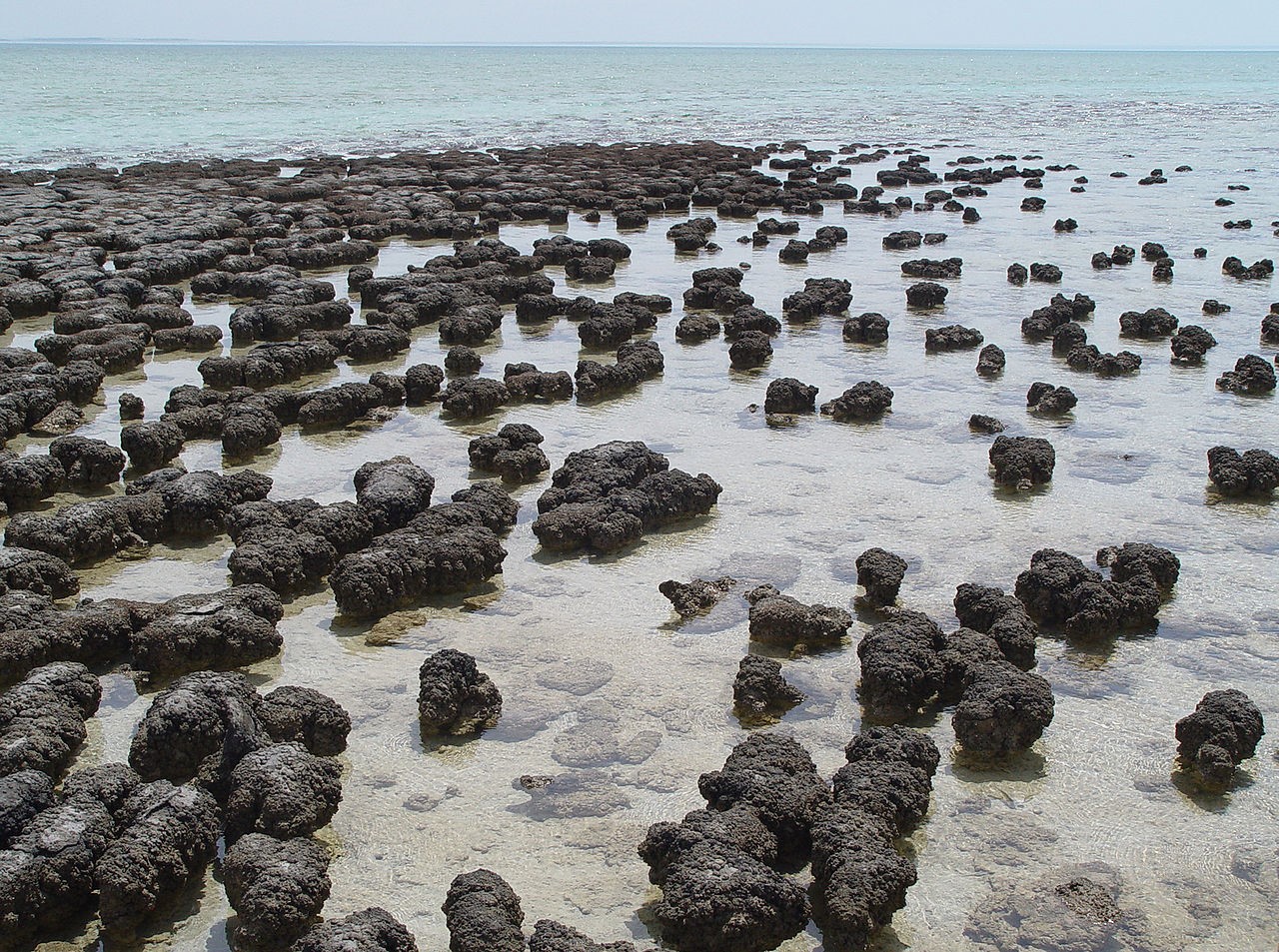
This next picture by Mark Wilson shows fossil Stromatolites about 420 million years old in Estonia. Although these relatively recent fossils show biological organisation in the form of traces of the structure of eukaryotic cells, older fossil Stromatolites exist, even as far back as 3.5 billion years ago, far before development of the eukaryotic cell. These structures could be due to the activity of prokaryotes similar to modern day blue-green algae and therefore not related to later eukaryotic based structures. However, whilst some very ancient Stromatolite structures do show some evidence of biological organisation, this is rare and many such structures could be a result of geological events rather than life. Because of the importance of this question, much geological activity is currently devoted to their study.
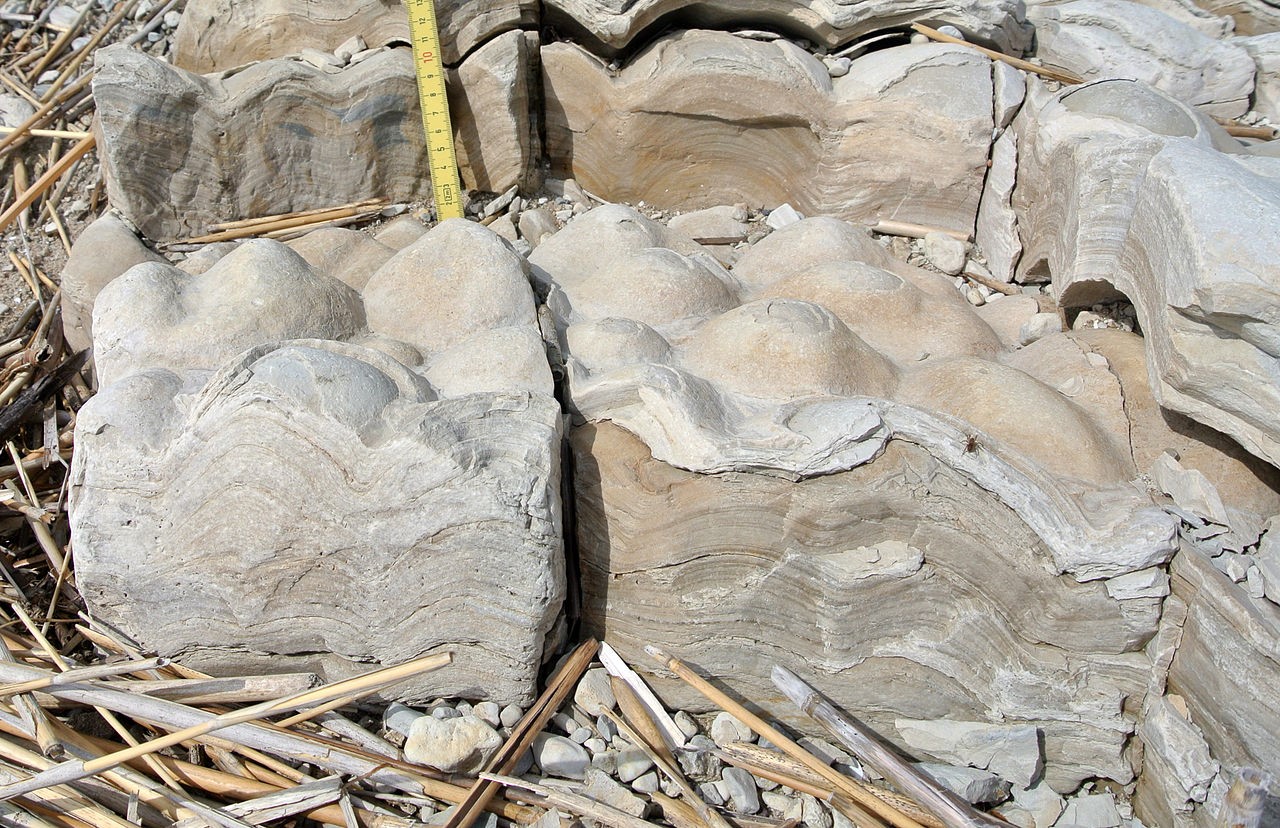
Accepting the above caution, Stromatolites are therefore some the most successful organisms ever to live on Earth. If you were betting on their survival 3.5 billion years ago, there may not have been many other species to bet on, but move forward to the Burgess Shale biota living 508 million years ago and there is a surprisingly diverse range of organisms on which you could, if caught by the whim of betting at that time, put money on the chance of their survival. This time you would lose on every bet placed: not one of the species, so rich in biological form and evidently abundant, has survived.
The Burgess Shale is a formation of mudstone around 500million years old, in geological terms Middle Cambrian, and is found in the Canadian Rockies of British Columbia. The fossils are particularly important since they are representative of the “Cambrian Explosion”, a term used to describe the rapid development of different body forms once life had cracked the problems issuing from adoption of multicellularity. It’s obvious that cellular specialism is useful, think of movement, sensing the environment, capture of food, digestion, but how to differentiate these specialised cells must have been an initial problem. In fact you could argue that this is a job only part finished in that cancerous cells, which show regression or de-differentiation, are unfortunately with us. The fossils were discovered by palaeontologist Charles Doolittle Walcott and his wife towards the end their field work season in 1909, the following picture shows Walcott with other members of his family working in the quarry.
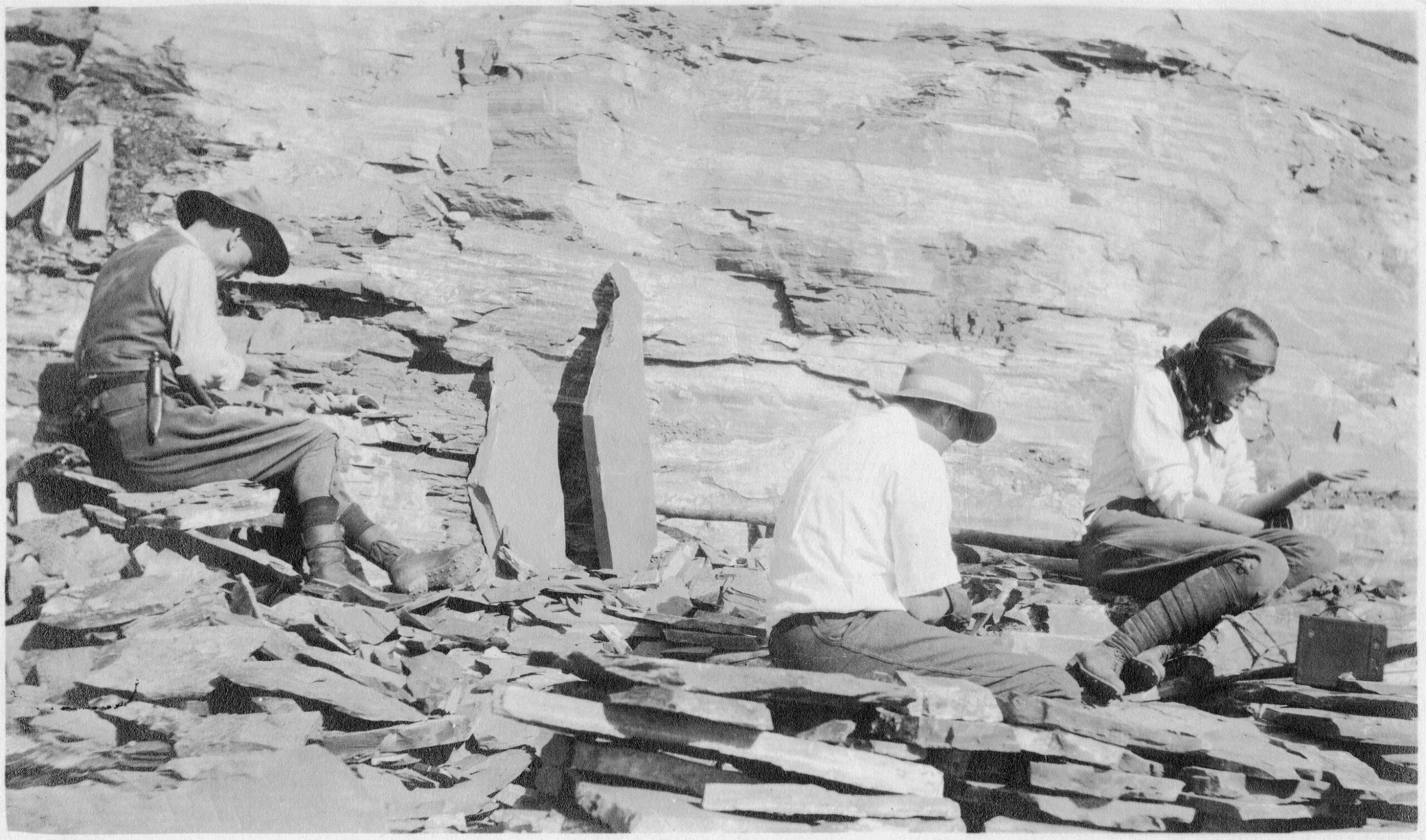
Charles Doolittle Walcott (1850-1927), Sidney Stevens Walcott (1892-1977), and Helen Breese Walcott (1894-1965)” by Smithsonian Institution of the United States
Walcott worked on classifying the organisms in the fossil remains using modern phyla. Here is a list of some of the more familiar animal phyla, just to remind you:
- Nematoda: Round worms with about 25,000 species, roughly half of which are parasitic eg hookworms which are, in many parts of the world, common parasitic infections causing debilitating conditions such as stunted growth, mental retardation in many mammals including man.
- Platyhelmintha: a group of simple flat worm shaped organisms lacking a coelom (body cavity), circulatory system and respiratory system. They are flat in shape to facilitate oxygen entry into their bodies by diffusion. Many parasitic, eg Schistosoma species causing the debilitating disease Bilharzia.
- Arthropoda: Joint legged animals with an exoskeleton of Chitin. Probably about 3.7million species.
- Mollusca: Mantle covering which in some species secretes a calcareous shell, muscular foot, rasping radula (teeth)
- Annelida: Segmented worms including the common Earth Worm.
- Brachiopoda: “Lamp-Shells”. Externally resemble bivalve molluscs but internally different
- Echinodermata: Radial symmetry: sea urchins, starfish
- Chordata: Animals with a dorsal stiffening structure and nerve chord: contains the vertebrates and related species such as the sea squirts (Urochordata) and the Lancets (Cephalochordata).
Following Walcott’s death in 1927, the fossils were neglected until the 1960s when they were examined afresh by a strong field of biologists including the Cambridge earth scientist Conway Morris. Initial study resulted in the exciting conclusion that some of the Burgess species did NOT belong to any of the traditional invertebrate phyla. These organisms were representatives of their own NEW phyla. Some example of this are as follows, note that these are artists’ reconstructions, not the original fossils:
Opabinia
The picture shows a reconstruction of the fossil Opabinia. When examined by the 1970s team it was thought to be a member of a new phylum (see Stephen J Gould’s excellent and readable book “Wonderful Life”).
More recent thought has placed it as a rather strange member of the Arthropoda.
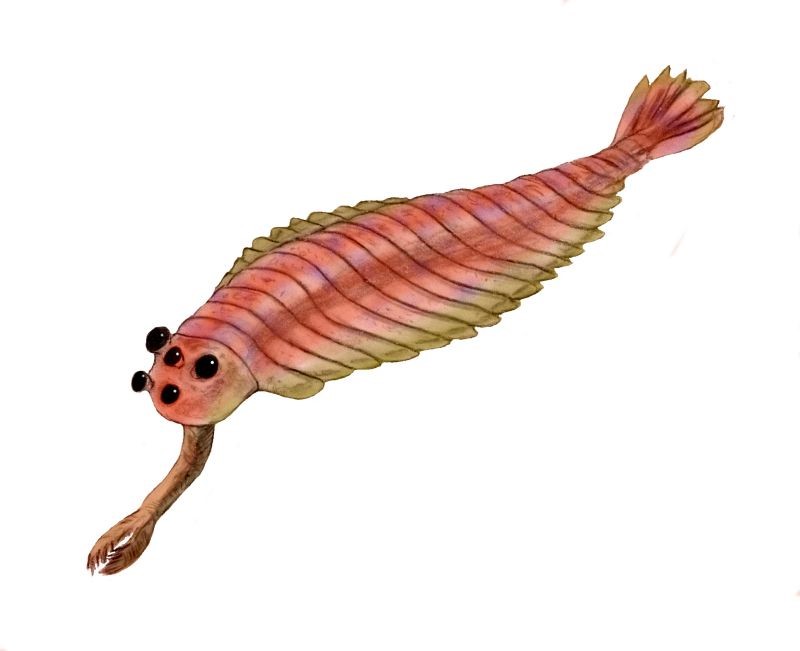
Hallucigenia
Another of the Burgess animals, this time Hallucigenia. Again this was initially assigned to its own phylum. In the original interpretation, the animal was shown upside down, walking on its spines. In this artist’s interpretation of the original fossils it appears with the spines as a protection and curiously, for a Cambrian fossil, with a benign expression ready for a walk on part in a children’s television program! Today it is considered to have been a member of the small phylum, Onychophora or “Velvet Worms”. Examples of modern members of the phylum are found in tropical and temperate zones of the Southern Hemisphere.
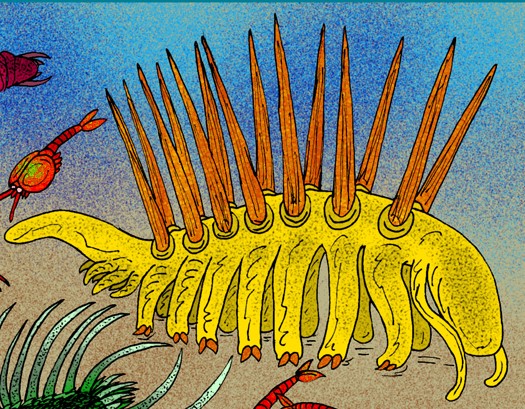
Anomalocaris
Even stranger is the animal Anomalocaris. This was originally known as two fossils, the jaws being one and the mouth assigned as a separate animal, thought to be a jellyfish. Indeed you can see how the mistake was possible from this artist interpretation of the fossil. It was a large animal, about half a metre in length and appears to have been a top predator amongst the Burgess biota. Trilobite fossils have been found with what appears to be bite marks made by Anomalocaris.
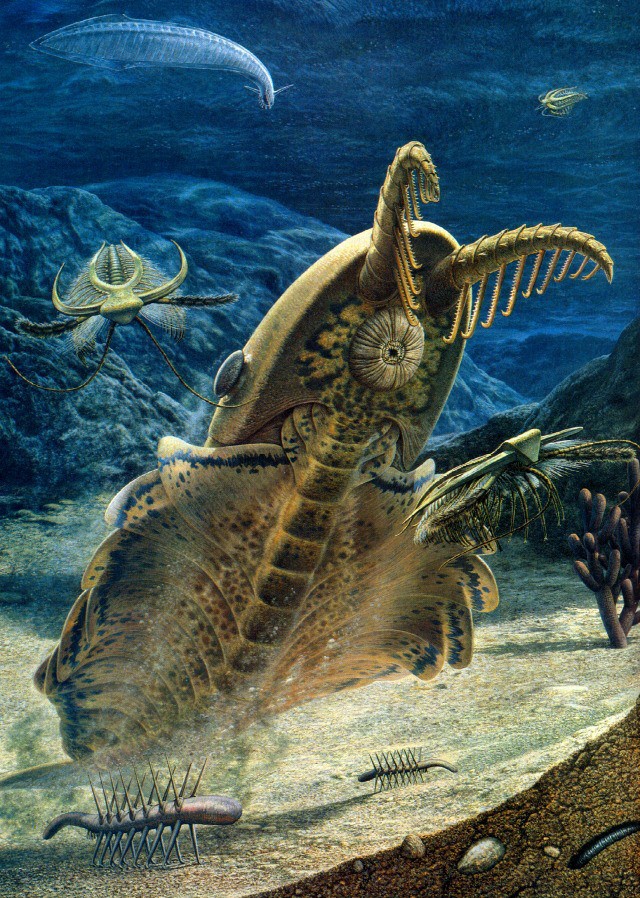
Of course these are artists’ drawings, interpreting the original fossil is a different matter. Here for comparison is a photograph of the original fossil of one of the tentacles of Anomalocaris:

Pikea
We have been discussing fossils of animals that only possessed vague relationship to ourselves, they are distinctly “Invertebrate” in structure, this one isn’t. This is Pikea gracilens, another fossil from the Burgess Shale, and is considered to be a very early member of our own phylum, Chordata. Notice the interpretation of the original fossil shows muscle blocks along the body of the animal; this is a characteristic of the Chordata (think of the structure of the fish in your fish supper). Pikea was a relatively small animal, about 5cm in length. It is very likely that other early Chordata species were present in the Mid Cambrian seas, but the limited amount of fossil evidence indicates they were not a common body plan. At the time, they would have seemed a bad bet on survival, but what significance they were to have later!
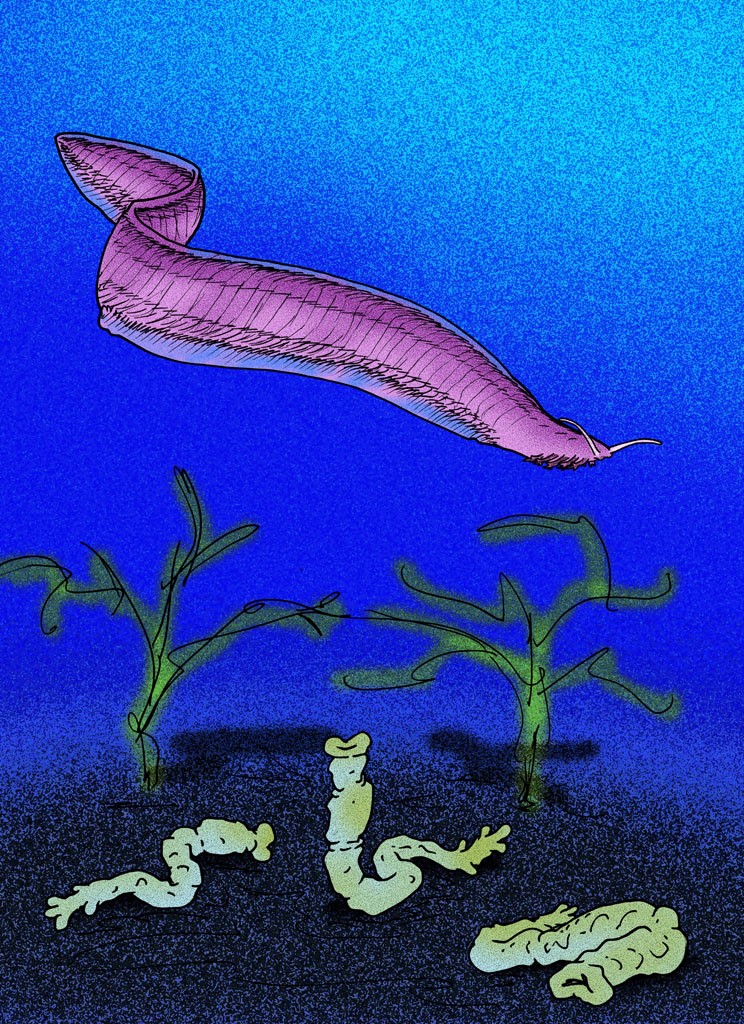
And finally one of the most prolific fossils to be found by Walcott and one which you can see in the Oxford University Museum:
Marella splendens
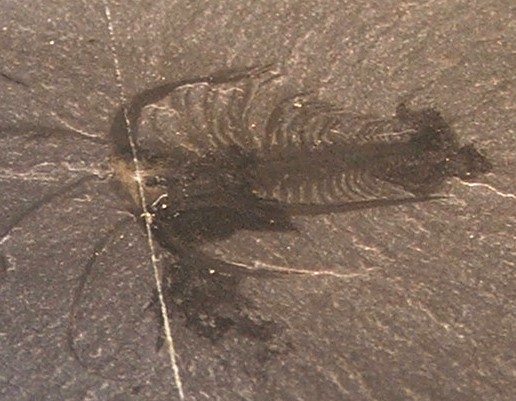
This is a fossil of the most abundant arthropod to be found in the Burgess Shale and like the others mentioned, owes its fossil appearance to the extraordinary preservation of its soft body parts. Obviously preservation of bone as a fossil is much more likely, but this is not possible for invertebrate animals. Here it is, for us to wonder at, preserved by a freak mud slide 508 million years ago and then not eaten or destroyed by rotting away probably because of a lack of oxygen in its tomb. What a wonder it is to look at! If you are not moved, then science is not for you!
In the next blog, we’ll have a look at the mass extinction events that have occurred over the last 2 billion years and try to find an argument for their positive effect on the evolution of life. Since we are unable to re-run the tape, whatever case we make will be untestable; but as far as intellectual ego is concerned, that may be another positive!
Well, it’s a good trick to go out on a high note and a fossil from the Burgess Shale certainly qualifies for that, so until the next blog,
Toodle-oo
Sphenodon.
This has been rather a long posting and the usual listing of where this work fits within typical A Level Biology courses will be attached to the next, hopefully shorter, blog.
Some Questions and Activities you might like
- How does the size of an animal affect its success?
- What advantages can you see in differentiation?
- Why did the “Cambrian Explosion” of diversification in body forms occur in a relatively short period? Can you imagine conditions where the same rapid evolution could occur in the future?
Reading around the subject
My major sources for the blog are worth having a look at:
- https://en.wikipedia.org/wiki/Burgess_Shale
- The background to the magical hold that the Burgess Shale has on us is “Wonderful Life” by the late Stephen J. Gould. As with the rest of his work, it is readable unlike so many textbooks, but it also is captivating. There is a warning: as well as possibly influencing your choice of career, Gould’s decision to re-write Walcott’s original intentions, that all of the fauna would fit in existing phyla, has been challenged and may not be so well accepted by palaeontologists today.
- http://paleobiology.si.edu/burgess/ This is the Smithsonian’s own site.
- https://en.wikipedia.org/wiki/Burgess_Shale_type_preservation This is a good resume of other geographical locations on the planet where similar biota to that of the Burgess Shale have been found. It is particularly good for the preservation process which enabled fossilisation of the soft body parts.
Image sources
- Image 1 – [Copyright licensed under CC BY-SA 3.0 via Wikimedia Commons – https://commons.wikimedia.org/wiki/File:Stromatolites_in_Sharkbay.jpg#/media/File:stromatolites_in_Sharkbay.jpg]
- Image 2 – [Copyright licensed under CC0 via Wikimedia Commons – https://commons.wikimedia.org/wiki/File:SoegininaStromatolitesEstonia.jpg#/media/File:SoegininaStromatolitesEstonia.jpg]
- Image 3 – [Copyright license: Wikimedia Commons – https://commons.wikimedia.org/wiki/File:Charles_Doolittle_Walcott_(1850-1927),_Sidney_Stevens_Walcott_(1892-1977),_and_Helen_Breese_Walcott_(1894-1965).jpg#/media/File:Charles_Doolittle_Walcott_(1850-1927),_Sidney_Stevens_Walcott_(1892-1977),_and_Helen_Breese_Walcott_(1894-1965).jpg]
- Image 4 – Attribution: “Opabinia BW” by Nobu Tamura [Copyright: via Wikimedia Commons – https://commons.wikimedia.org/wiki/File:Opabinia_BW.jpg#/media/File:Opabinia_BW.jpg]
- Image 5 – Attribution: Hallucigenia sparsa” by Apokryltaros . [Copyright Licensed under CC BY 2.5 via Wikimedia Commons – https://commons.wikimedia.org/wiki/File:Hallucigenia_sparsa.JPG#/media/File:Hallucigenia_sparsa.JPG]
- Image 6 – [Attribute: http://bioteaching.com/the-history-and-significance-of-anomalocaris/]
- Image 7 – Attribution: “Anomalocaris canadensis grasping claw, Burgess Shale” by James St. John. (Burgess Shale Formation, Middle Cambrian; Walcott Quarry, above Field, British Columbia, Canada). [Copyright Licensed under CC BY 2.0 via Wikimedia Commons – https://commons.wikimedia.org/wiki/File:Anomalocaris_canadensis_grasping_claw,_Burgess_Shale.jpg#/media/File:Anomalocaris_canadensis_grasping_claw,_Burgess_Shale.jpg]
- Image 8 – Attribution: Apokryltaros [Copyright: This file is licensed under the Creative Commons Attribution-Share Alike 4.0 International license.]
- Image 9 – Attribution Verisimilus [Copyright Wikimedia Commons http://creativecommons.org/licenses/by/2.5)]
